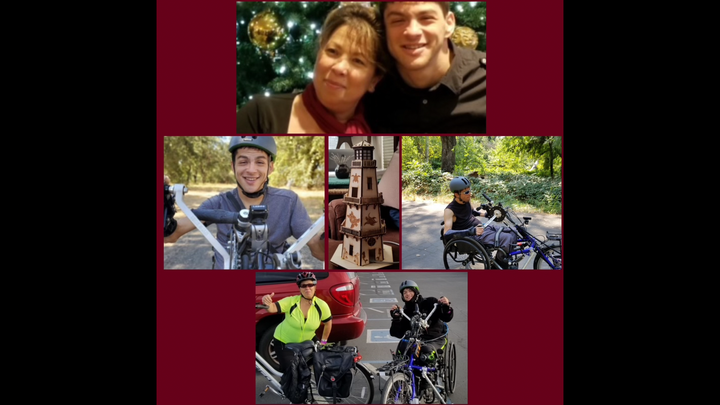
Help keep Garrett going
Garrett Bramhall is at risk of losing his mobility and what little independence he has, if he isn’t soon able to replace the hand cycle for his wheelchair with a power-assisted one which requires less strength on his part. The unit itself is $10,050, plus $250 shipping; the hand grips are sold separately for about $300. The 35-year-old Chico, CA, resident and his mom – family friends of mine -- are appealing for donations to assist them with the cost. As beneficiary, Garrett will directly receive all donations made to this GoFundMe.
Netta Bramhall has been a single mom from the start. She knew it wouldn’t be easy, but she and Garrett have faced some special circumstances that have made it much more challenging than she ever could have imagined. At age 2, Garrett was diagnosed with Type1 Diabetes, presenting life-long health issues but particularly difficult to navigate when he was such a young child. Then at the age of 5, Garrett had to have open heart surgery to repair holes in his heart which caused his heart to be enlarged. While the surgery was successful, he to this day needs to periodically monitor his heart rate because it is slower than normal - especially while he’s sleeping.
Despite all this, Netta was able to go to school, become a certified nursing assistant and get a job at a hospital. Of course, she had to resist being overprotective of Garrett. She recalls how Garrett’s doctor used to tell her “not to let him sit on the couch,” warning that he needed to remain active, and not become overweight, because of his diabetes. So Netta let Garrett do all the things other kids were doing. Garrett was doing just that one day, at age 14, when he performed a jump on his BMX bike and landed wrong. He broke his neck at level C4-C5, severing his spinal cord and leaving him a quadriplegic. This tragic accident turned their lives completely upside down, but the mom and son team figured it out and made it through.
One of the real blessings along the way was tendon transfer surgery that Garrett was able to have done on his arms at Shriners Hospital in Sacramento, CA. The surgery made it possible for Garrett to lift his arms. While he still has no fine motor skills, he is able to use various hand attachments to enable him to eat and perform other tasks.
Because the tendon transfer restored some movement to his arms, he was able to get a hand cycle for his wheelchair. A hand cycle basically adds a wheel and hand “pedals” which power it to the front of the chair. His mom used her income tax refunds and savings to purchase that one, much less expensive than the motorized one he now needs.
Netta – now a home health care worker - cared for Garrett at home until five years ago when he moved in with a friend who also is a quadriplegic. A caregiver comes to the house for four hours every morning to get Garrett up, cleaned up, and dressed and to tend to any medical needs, as well as laundry and housework. A caregiver comes again for five hours at night for dinner and to get Garrett ready for bed.
Someone needs to attach the hand cycle to Garrett’s wheelchair for him, but once that is done and he is in the chair, he’s able to go places and do things on his own that he otherwise could not do. For example, prior to the pandemic, he attended classes and went to rehab. He now enjoys going to a “Fab Lab” where, with the help of a tech and using “tendon splints” for hand movements, he is able to create some elaborate projects using a 3D printer. For Mother’s Day, he made Netta a lighthouse to add to her collection – it is a gift she will forever cherish.
Garrett also enjoys being outdoors and his hand cycle allows him to exercise when he rides it on trails. The exercise helps control the debilitating muscle spasms Garrett suffers. He and his mother often ride together and have competed in many community cycling events through the years.
Sadly, Garrett’s health has deteriorated in the last few years. He has developed some gastro-intestinal issues related to his diabetes and has lost a lot of strength due to his muscles atrophying. It is becoming increasingly difficult for him to use his arms to “pedal” the hand cycle he now has. That is why he is looking to replace it with a “Stricker Lipo Smart Tetra,” a hybrid cycle with a sensor that transmits the crank movement to a controller that then automatically switches on the battery, activating the engine and transforming the hand cycle to an “e-bike”. The brake system, gear system and hand grips on the cycle need to be specific to the individual rider’s needs because not all spinal cord injuries are the same.
Netta emphasizes why it is so important for Garrett to have the new power-assisted hand cycle, so he can continue to get around on his own. “It provides a sense of normalcy and independence,” she said. “He has very little quality of life. He needs this in order to get out and feel good.”